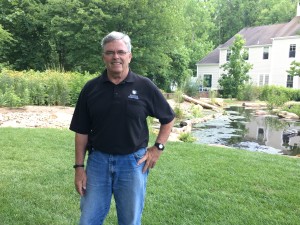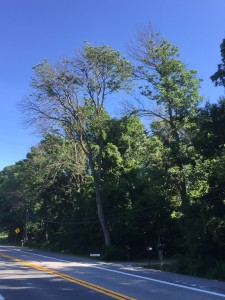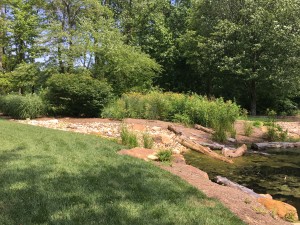
Tony Dove in the garden pond in front of the SERC Administration Building. (Photo: Emily Li/SERC)
by Emily Li
What do we do when native plants lose? About five years ago, the Smithsonian Environmental Research Center and the U.S. Department of Agriculture joined forces to back up seed sources of native plant species, just in case something threatens to wipe them out—but for some species, it looks like we might need them sooner rather than later. Learn more about the partnership and the pros of gardening with natives in this edited Q&A with Smithsonian Environmental Research Center horticulturalist Tony Dove.
Can you tell me about the native sentinel plant species partnership between SERC and the Department of Agriculture?
The Department of Agriculture has a woody plant germplasm conservation center in Beltsville. And what they do is they go around to different locations throughout the country and they collect seeds of various native plants. They grow those native plants in a nursery with the expectation that they will then take those plants and put them out into landscapes in different areas, so that there will always be a seed source for those particular plants if something tragically happens in the area where those plants grew.
How did SERC get involved in the project?
There was a gentlemen [at the conservation center] who’s in charge of that called Kevin Conrad. And Kevin contacted me and we put some of [the native woody plant seeds] along the four ponds by the woodland parking lot. There’s also some up at the Homestead House. … It certainly is a good cooperative venture between the Smithsonian Environmental Research Center and the Department of Agriculture, but also—the plants are free! And they’re pretty and we get to use them!
Could you give an example of when seeds like this could be needed?
Right now there’s an insect pest, emerald ash borer, that’s killing all the ash trees. If you drive around here, you’ll see them all dying. They have those plants of this genotype, this particular pool here, that will be planted somewhere else—maybe out in the West Coast or something—where the insect’s not there. It takes about 13 years for that insect to kill off all the trees, and then because there’s no food left for it, it dies off. And once that happens, then they can start reintroducing.

Green ash trees (Fraxinus pennsylvanica) infested by Emerald ash borer. (Photo: Tony Dove/SERC)
…
Kevin actually came through a few years ago and collected seeds of the ashes around here, knowing that that was going to be a problem, and then distributed them out in the West Coast… Then they can bring them back after the initial insect is gone.
In the future, is this whole garden going to be native plants?
There was a garden planted before I got here—with iris, you see bearded iris which certainly isn’t native, there’s some evergreen azaleas, which are not native, and some other plants that are not native. I have sort of taken it over and allowed it to go more native. I’m allowing [the milkweed] to crowd out all the peonies and irises and things like that since I think milkweed is a bit of a better plant since it’s native.
…
When they did this pond two years ago, it sort of changed the whole way this whole garden looked. It was a good opportunity to use some of these areas which had not been planted in the past for some of our native plants.
Why is combating invasive species so important?
I’ve been at SERC for 10 years and when I got here, Japanese stiltgrass was just starting to get here, and it’s absolutely everywhere now. … And deer don’t eat Japanese stiltgrass, but they do eat the one or two oaks that try to germinate. Really, the balance is out of whack. When you clear an area now, if you thin an area out of native trees, usually the first things that come back are Japanese stiltgrass, mile-a-minute weed, oriental bittersweet, those sort of things.
…

The garden pond where Dove is shifting the focus to native species. (Photo: Emily Li/SERC)
There are some insects obviously and other animals that are more dependent on native species, since they both evolved here, than these new introduced species. New introduced species usually have no natural controls, so they just overtake everything. And that’s why I want to go with native species more here, so people can see the native species—that they are ornamental, so why not plant them and benefit not only your aesthetics, but also native insects and animals? We’ve got some pretty things here that are native, and if people can see that maybe they’ll start planting them more.

